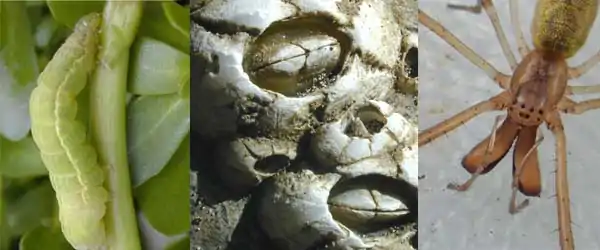|
Chapter 12 ~ The Arthropods
Contents ~ Introduction ~ Protozoans ~ Metazoans ~ Sponges ~ Cnidaria |
 The three largest groups within the Phylum Arthropoda are the insects (moth larva), crustaceans (barnacle), and arachnids (spider). |
Introduction to the Arthropods
Arthropods (Phylum Arthropoda) constitute the largest phylum of animals, and include the insects, arachnids (e.g., mites, ticks, spiders), crustaceans (crabs, lobsters, shrimp), and other similar creatures. Between 75 and 80% of all organisms on planet Earth are arthropods—over a million modern species are known, and the fossil record reaches back to the early Cambrian. However, species in the world's tropical forests remain largely undiscovered; Thomas (1990) estimated that perhaps 6 to 9 million species are yet to be discovered in this environment alone. Arthropods are common in all environments, and include symbiotic and parasitic forms. They range in size from microscopic plankton (~0.25 mm) up to forms several metres long.its class insecta bear almost 1.4-1.5 million species.
Because this group is so large, we will devote the next several chapters to the various subgroups: the subphyla and classes of arthropods.
- Read Arthropods (Links need not be persued at this time)
The Trilobites
Because of the hard exoskeleton, arthropods tend to make excellent fossils. A particularly large group of arthropods known as trilobites are known only from the fossil record: florishing in Cambrian seas and into the lower Palaeozoic. The last of the triliobites disappeared at the end of the Permian.
- Read Trilobitomorpha
References
- Thomas, C. D. 1990. Fewer species. Nature, 347: 237.